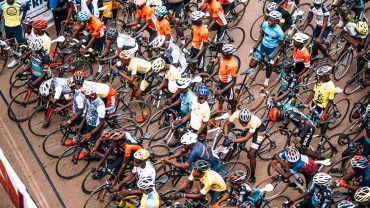Bonthe is like a sun-bleached photo taken of an exotic island town, where you can see things once were bright and new, but now all that’s left is a vague image of what used to be. And there’s a melancholic beauty to that. Walking along the once booming boulevard you pass by dozens of abandoned buildings, reclaimed by tropical vegetation. Relentless sun and ocean air have stripped these buildings of their vitality, and the result is a poetic pastel of old times.
History
In the past, Bonthe was a thriving trade hub and economic centre. During the two world wars, the French and English navy used the town as a naval base. In the 80’s, palm products and sea food became major industries. Now, however, a run-down warehouse and some petty trading is all that remains.
In addition, Bonthe has a rich colonial history, and remnants of this past can be found all over town. Telephone booths, rusted street signs and water pumps all stem from this era.
Warm, welcoming
The people of Bonthe are enveloped by island tranquility. Slow walks, a reflection of the sea cemented into their eyes, and broad smiles that indicate that ‘everything is fine’. At first they might look at you with a mixture of curiosity and reservation, but a smile and a greeting will warm them and bring out their welcoming nature. Locals are happy to chat with you, show you around, introduce you to your families and leave you in peace when you prefer that.
Activities
Walking around Bonthe is an attraction in itself. A guided tour past the historical sights gives you a peak into the rich past of the town. Old Krio board houses with faded paint stand next to unfinished constructions, overgrown with tropical vegetation. Goats roam around, eating their share of flowers and leaves. As there are barely any motor vehicles on the island, this tour is undisturbed by honking cars and speeding bikes.
For those who prefer water activities, you can go on a fishing trip with local fishermen, or engage in Tarpon fishing through the Bonthe Holiday Village accommodation. It is a costly adventure, but Bonthe is actually famed for its rich estuary. Apart from Tarpon, fish such as mackerel, jack, barracuda and grouper can be found in the waters.
There is not really a beach for swimming in Bonthe. Smaller beaches can be accessed at other parts of Sherbro Island and require you to hire a local ‘kunu’ or motorboat.
If you feel like partying, Bonthe has a multipurpose hall where they sometimes hold functions on the weekend. For sports and cultural activities, you can visit the playfield, an open football field surrounded by palmtrees. A variety of events can take place, such as football matches, athletics, and fashion shows. There is no official calendar, just ask anyone what’s happening when and you’ll find out.
All in all, visiting Bonthe is a mesmerising experience. Strolling down the sandy roads past mud houses and abandoned colonial structures, undisturbed by vehicles and noise, one can experience what life in Sierra Leone must have been like a century ago. Before industry and modernisation and a growing connectedness to the outside world changed the pace of life. There are not many activities or bombastic attractions, but for those who appreciate interactions with the locals, the forest, the sea and wish to remove themselves from the distractions of modern life, Bonthe is an excellent place to visit.
Good to know
- There are no western-style restaurants in Bonthe. To arrange for food, ask around for someone who can prepare meals for you. This should be arranged in the morning, and the cook can prepare Sierra Leonean dishes for a couple of dollars.
- Although Bonthe is safe, it is not recommended to walk around without a guide for longer periods of time. As the town is divided in four townships, it is customary to greet the townchief and explain your purpose of visiting. It is not a must, but it will be appreciated and considered as a sign of respect.
- The general advice for visiting tropical locations counts here as well. Bring sun protection and mosquito repellent, drink plenty of water and avoid strenuous activities during the hottest part of the day.
- The ferry from Yargoi to Bonthe leaves once a day at 4pm. The ferry from Bonthe to Yargoi leaves at 8am daily.
How to get there
It takes 5-7 hours to get from Freetown to Yargoi, a coastal village where the local ferry to Bonthe leaves from every day at 4pm. Popularly known as ‘pam pam’, the wooden motorboat can take about 30 people for 15.000 leones. It takes about two hours to reach Bonthe.
Where to stay
Although Bonthe does not offer many options when it comes to accommodation, it is certainly possible to lodge in comfortable and clean rooms. By far the most suitable option is Bonthe Holiday Village. They offer chalets with two or three A/C equipped rooms in a beautifully decorated compound. Rooms can be pricy though, so for a more budget option you can see whether Mam’aa Guesthouse has any availability.
Bonthe Holiday Village
Rooms Bonthe Holiday village has six chalets, of which five have three rooms and one has two rooms
Costs for bed and breakfast: 120$ per room, can be reduced during low-season
Availability should be checked at least 48 hours in advance through VSL
Facilities include A/C, warm water, clean toilets, bedding and towels, soap and a secured compound. Rooms are decorated with local art and contain a mini fridge. The generator runs in the evening only.
Mam’aa Guesthouse
Costs Single room 70.000SLL, double room 130.000SLL
Availability should be checked at least 48 hours in advance by calling Julian Palmer- +23278082456 of Mrs. Macauley +232777838617
Facilities the single room has a shared bathroom which requires well-developed squatting skills. The double room is self-contained. All rooms have mosquito nets and access to a shared verandah.
Location Victoria road, a few minutes walk from the jetty
- About the Author
- Latest Posts
Esther Kamara is a Dutch-Sierra Leonean that was born and raised in Amsterdam. After finishing her bachelor Media Studies from the University of Amsterdam she moved to Freetown, where she now works as a freelance writer and artist manager. Her brainchildren are otherworldly short stories and peculiar drawings of non-existing characters.




Comment (0)